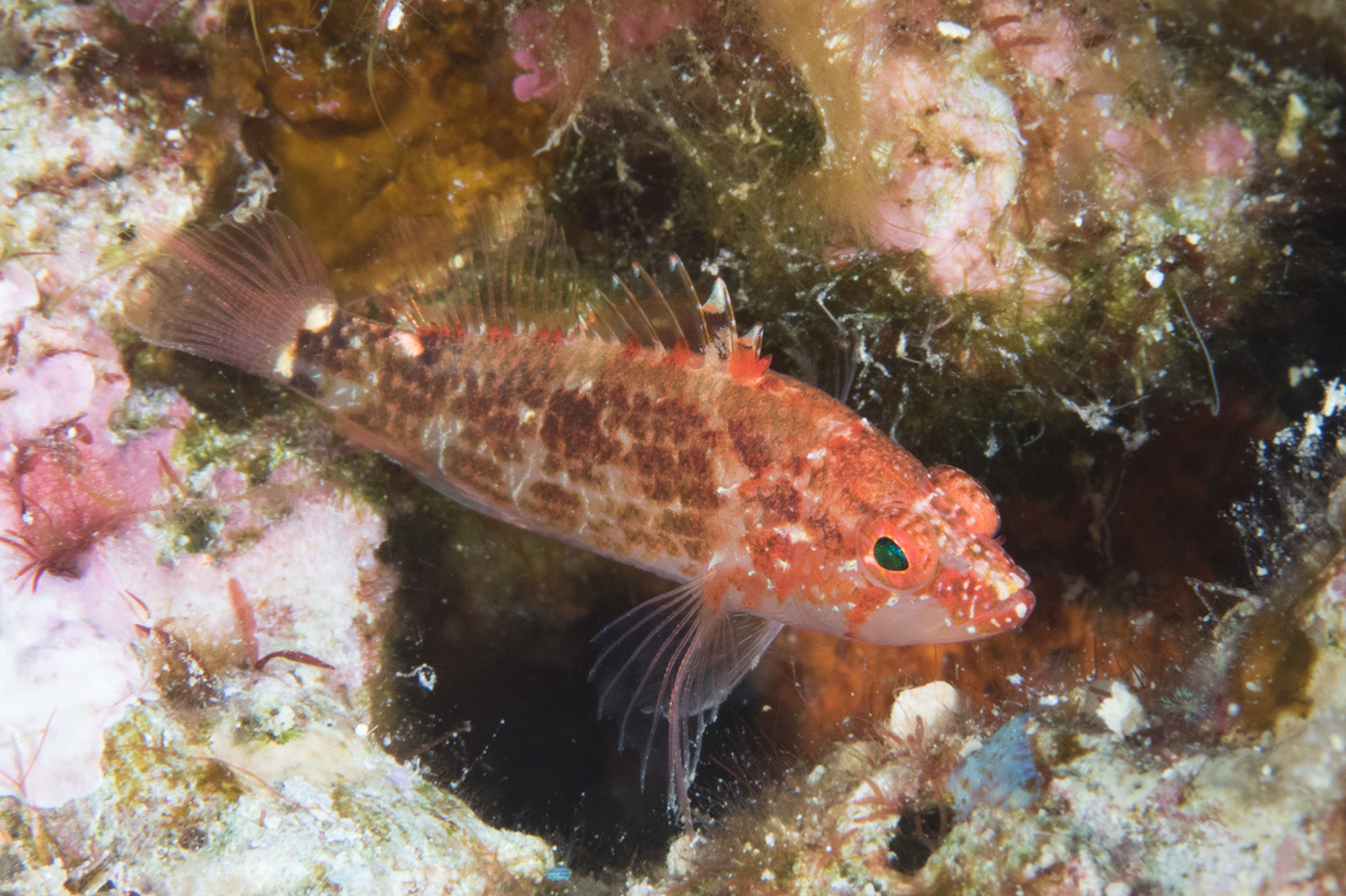Longfin Perchlet, Plectranthias longimanus Weber 1913
Other Names: Long-finned Basslet, Silverspots

A Longfin Perchlet, Plectranthias longimanus, in northern Fiji, November 2017. Source: Mark Rosenstein / iNaturalist.org. License: CC by Attribution-NonCommercial-ShareAlike
Summary:
A pale perchlet with interconnected large brownish blotches forming irregular bars along the side, a dark brown spot at the rear base of the dorsal fin, one at the upper end of the caudal peduncle just before the caudal-fin base, one at rear base of the anal fin, and one on the lower caudal peduncle between the last two spots, indistinct smaller dark spots along bases of the dorsal and anal fins, and an oblique bar below the eye. The larger dark spots are usually immediately followed by a bright white spot.
Cite this page as:
Bray, D.J. 2021, Plectranthias longimanus in Fishes of Australia, accessed 10 Jul 2025, https://fishesofaustralia.net.au/home/species/1715
Longfin Perchlet, Plectranthias longimanus Weber 1913
More Info
|
Distribution |
The Kimberley and offshore reefs of north Western Australia, and the far northern Great Barrier Reef, and reefs in the Coral Sea, to Stradbroke Island, Queensland. Elsewhere the species is widespread in the Indo-west-central Pacific. Inhabits shallow to deep reefs, sheltering in crevices, amongst small boulders and on rocky, patch and coral reefs, as well as coastal sand slopes with rich invertebrate and algae growth. |
|
Features |
Dorsal fin X,12-15, fin margin divided to the base before soft-rayed part, 4th spine longest; Anal fin III,6-7, 2nd spine longest, twice length of first spine but shorter than longest anal-fin ray; Caudal fin 13-15 branched rays, truncate to slightly rounded; Pectoral fin 12-13, all rays unbranched, fin reaches vertical at 5th anal-fin ray; Pelvic fins not reaching anus; Gill rakers 4-6 + 9-12; Lateral line 12-15 tubed scales, incomplete, ending below dorsal-fin rays; Scale rows above lateral line to 5th dorsal-fin spine 1; Circumpeduncular scales 12. Greatest body depth 2.6-3.1 in SL. Scales on top of head reach middle of interorbital space; operculum scaled; cheek with four oblique rows of large scales; snout, maxilla, suborbitals and lower jaw naked. Preopercle posterior margin with about 12 small serrae, lower margin with two well-separated antrorse spines, subopercle and interopercle serrate. |
|
Colour |
Body pale; series of brown zigzag stripes or bars along side; square black spot at base of upper and lower 6 caudal-fin rays, followed posteriorly by a golden yellow spot above and below a smaller black spot on upper and lower middle caudal rays; black spot on each side of a white spot at base of anal-fin rays; proximal part of dorsal fins reddish brown; dorsal-fin spines 4 to 7 with red tips; dark brown square blotch at base of last 6 dorsal-fin rays; several small, irregular white spots scattered over head and body; head and lower abdomen white; snout and front of lower jaw reddish brown. |
|
Similar Species |
The similar Dwarf Perchlet, Plectranthias nanus, has a pale bar on the caudal-fin base, edged posteriorly by a narrow dark vertical bar (or a series of short bars). |
|
Etymology |
The specific name longimanus is from the Latin longus (= long) and manus (= hand), in reference to the elongate pectoral fins of this species. |
|
Species Citation |
Plectranthias longimanus Weber 1913, Sitzungsberichte der Akademie der Wissenschaften in Wien. Mathematisch-Naturwissenschaftliche Klasse 57: 209, fig. 54. Type locality: Paternoster Island, East Indies, Siboga station 315, depth 36 m. |
|
Author |
Bray, D.J. 2021 |
|
Resources |
Longfin Perchlet, Plectranthias longimanus Weber 1913
References
Allen, G.R. & Erdmann, M.V. 2012. Reef fishes of the East Indies. Perth : Tropical Reef Research 3 vols, 1260 pp.
Gill, A.C., Pogonoski, J.J., Moore, G.I. & Johnson, J.W. 2021. Review of Australian species of Plectranthias Bleeker and Selenanthias Tanaka (Teleostei: Serranidae: Anthiadinae), with descriptions of four new species. Zootaxa 4918(1): 1-116. https://doi.org/10.11646/zootaxa.4918.1.1
Johnson, J.W. 2010. Fishes of the Moreton Bay Marine Park and adjacent continental shelf waters, Queensland, Australia. pp. 299-353 in Davie, P.J.F. & Phillips, J.A. Proceedings of the Thirteenth International Marine Biological Workshop, The Marine Fauna and Flora of Moreton Bay. Memoirs of the Queensland Museum 54(3)
Kuiter, R.H. 2004. Basslets, Hamlets and their relatives. A comprehensive guide to selected Serranidae and Plesiopidae. Chorleywood, UK : TMC Publishing 1, 216 pp.
Moore, G.I., Morrison, S.M., Hutchins, B.J., Allen, G.R. and Sampey, A. 2014. Kimberley marine biota. Historical data: fishes. Records of the Western Australian Museum, Supplement 84: 161-206
Randall, J.E. 1980. Revision of the fish genus Plectranthias (Serranidae : Anthiinae) with descriptions of 13 new species. Micronesica 16(1): 101-187 figs 1-32 See ref online
Randall, J.E. 1996. Two new anthiine fishes of the genus Plectranthias (Perciformes: Serranidae), with a key to the species. Micronesica 29(2): 113-131. See ref online
Randall, J.E., Allen, G.R. & Steene, R. 1990. Fishes of the Great Barrier Reef and Coral Sea. Bathurst : Crawford House Press 507 pp. figs.
Randall, J.E., Allen, G.R. & Steene, R. 1997. Fishes of the Great Barrier Reef and Coral Sea. Bathurst : Crawford House Press 557 pp. figs.
Weber, M. 1913. Die Fische der Siboga-Expedition. Sitzungsberichte der Akademie der Wissenschaften in Wien. Mathematisch-Naturwissenschaftliche Klasse 57: 1-710 123 figs 12 pls See ref at BHL
Williams, J.T., Lawrence, A. & Myers, R. 2016. Plectranthias longimanus. The IUCN Red List of Threatened Species 2016: e.T69588828A69592447. http://dx.doi.org/10.2305/IUCN.UK.2016-3.RLTS.T69588828A69592447.en. Downloaded on 02 October 2018.





